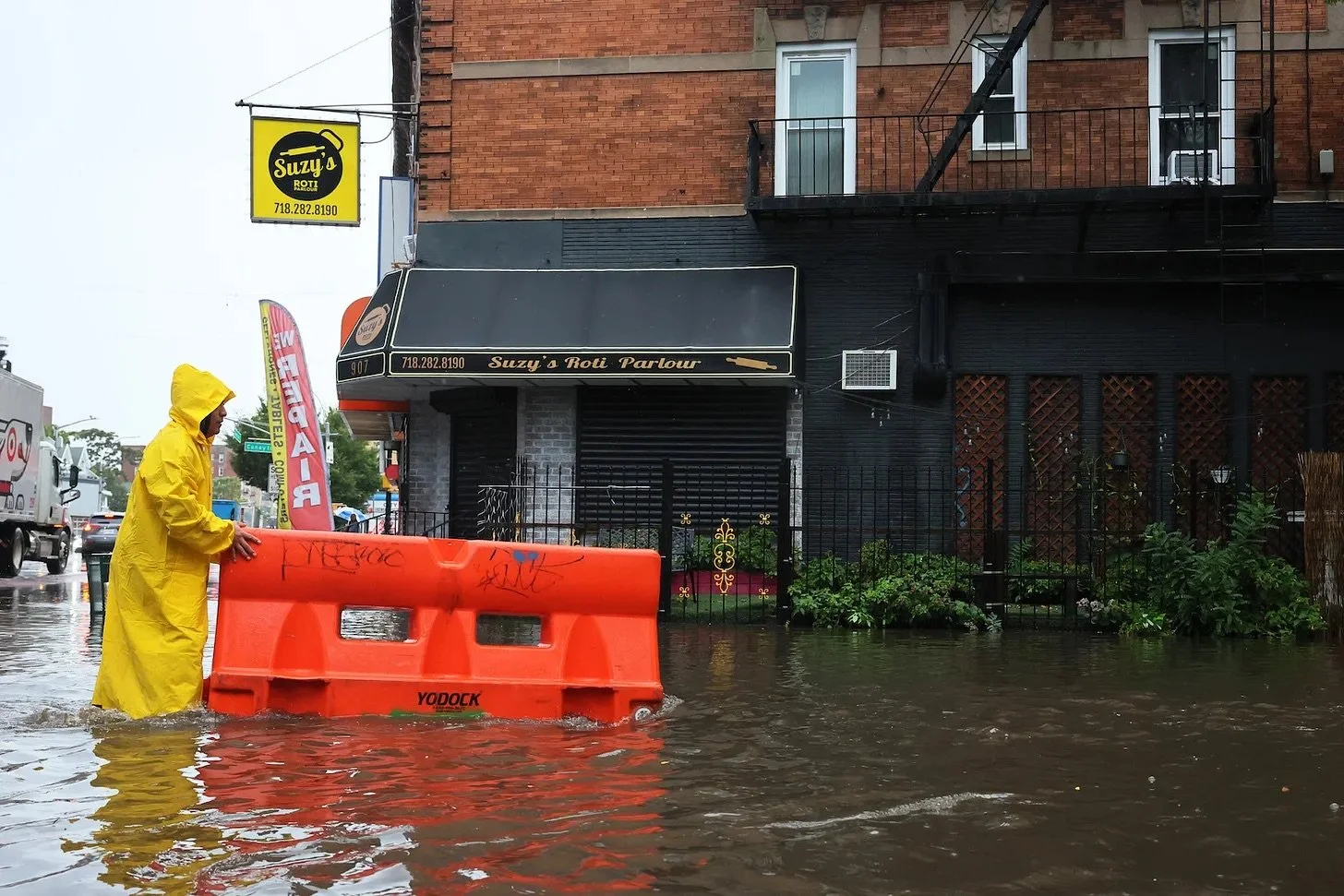Technically, that New York City flood was “mild”



A person pushes a barricade in Flatbush, Brooklyn amid the coastal storm on September 29, 2023. Source: Michael M. Santiago/Getty Images
If we want to understand the full picture of climate-fueled flood risk to New York City, we can’t just look at rainfall.
If you read the news or scrolled social media this weekend, you probably heard that New York City experienced record-breaking rainfall and catastrophic flooding last Friday.
You probably heard that LaGuardia Airport shut down a terminal; that subway lines transformed into cesspools; that a whirlpool formed in Brooklyn; that a sea lion escaped its enclosure in the Central Park Zoo.
But what you may not have heard, as I hadn’t before yesterday, is that scientists who study coastal flooding actually consider Friday’s flood to be “mild.” That’s because, while the rainfall itself was record-breaking—more than 8.65 inches fell at JFK airport—the coastal flood level was only two feet above high tide.
That level of flooding is classified as an annual flood, said Kelly Van Baalen, project manager of Climate Central’s sea level rise team. “The numbers on the rainfall are a piece of it, but you would expect coastal flooding of this sort every year,” she said.
The coastal flooding aspect of Friday’s story is important to understand, Van Baalen argues, as it paints a more accurate picture of the danger New York City is truly facing as the climate continues to destabilize due to fossil fuels, deforestation, industrial agriculture and mass consumption.
If we’re only looking at the rainfall piece, we’re only seeing half of the picture–and blinding ourselves to the dire need for solutions.
New York’s flood: A wet double whammy
In New York City, climate change is worsening floods in two important ways. It is exacerbating rainfall, which can quickly lead to flash flooding due to the city’s lack of porous surfaces. It’s also slowly raising the level of the ocean, which frequently intrudes onto the city’s surfaces during storms and high tide, a phenomenon known as coastal flooding.
Though they may have appeared to be solely flash floods, Friday’s floods in New York were actually a double-whammy: A combination of pluvial flooding caused by rainfall, and coastal flooding (storm surge) exacerbated by supermoon-induced high tides from the city’s surrounding rivers and bays.
The rainfall portion–which caused most of the flooding–was anything but mild. “Eight inches of rainfall in 24 hours is just incredible,” said Climate Central meteorologist Lauren Casey. “On average in New York, you would likely see four inches for the entire month.”
But the coastal flooding portion, while definitely bad, was fairly typical. “The coastal water levels at the Battery last Friday were just below NOAA's minor flood threshold,” Van Baalen said. “So from a coastal flooding standpoint, you are correct that this was a ‘mild’ flood we can expect at least once a year going forward.”
Had Friday’s record rainfall accompanied a stronger storm, like a hurricane, the coastal flooding aspect could have easily been far worse. There are two levels of coastal flooding above what occurred on Friday: moderate and major. A major flood is the so-called “hundred-year” flood, which is supposed to have the statistical chance of occurring once a century.
Unfortunately, experts now expect those major “hundred-year” coastal floods to inundate New York City once every 20 years. And as climate change worsens sea level rise, experts expect that gap to narrow further. According to NOAA, sea levels along U.S. coasts are expected to rise as much over the next 30 years (10-12 inches, on average) as they did over the last 100 years. If that happens, a “mild” New York City coastal flood in 2050 will be about two feet higher than the one on Friday.
We point this out not to scare our readers, but to caution them against the inevitable excuses from politicians who will say that Friday’s flooding was out of the ordinary. Yes, it was a catastrophic event, and in some ways it was historic. But it was also entirely predictable, given what scientists know about climate change. And it was not even close to a worst-case scenario.
As much as we hate the “new normal” cliche, that’s the reality of what New York City’s extreme floods are. And clearly it’s not cliche enough, because it doesn’t seem to have gotten through city or state officials’ heads. It’s been well-documented that policies to adapt the city’s infrastructure aren’t moving quickly enough to adapt to the reality of climate change; despite three devastating hurricanes over the last decade, the city’s aging sewage system and infrastructure remain the same. And Mayor Eric Adams’ response to intense criticism over his handling of the emergency (he went to a fundraising event on Thursday night instead of warning the public about flash flooding) wasn’t to reassess the city’s warning protocol. It was to say, “If anyone was caught off guard, they had to be living under a rock.”
It’s not the responsibility of individuals to prepare their cities for climate change. But it is within their power to pressure leaders into putting more urgent climate adaptation plans in place. And effective pressure starts with the knowledge that flooding events like Friday’s aren’t outliers.
They’re warnings of what’s to come.



